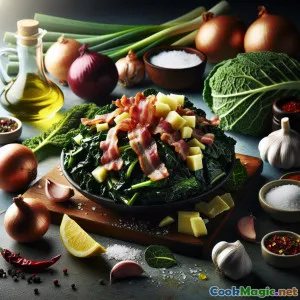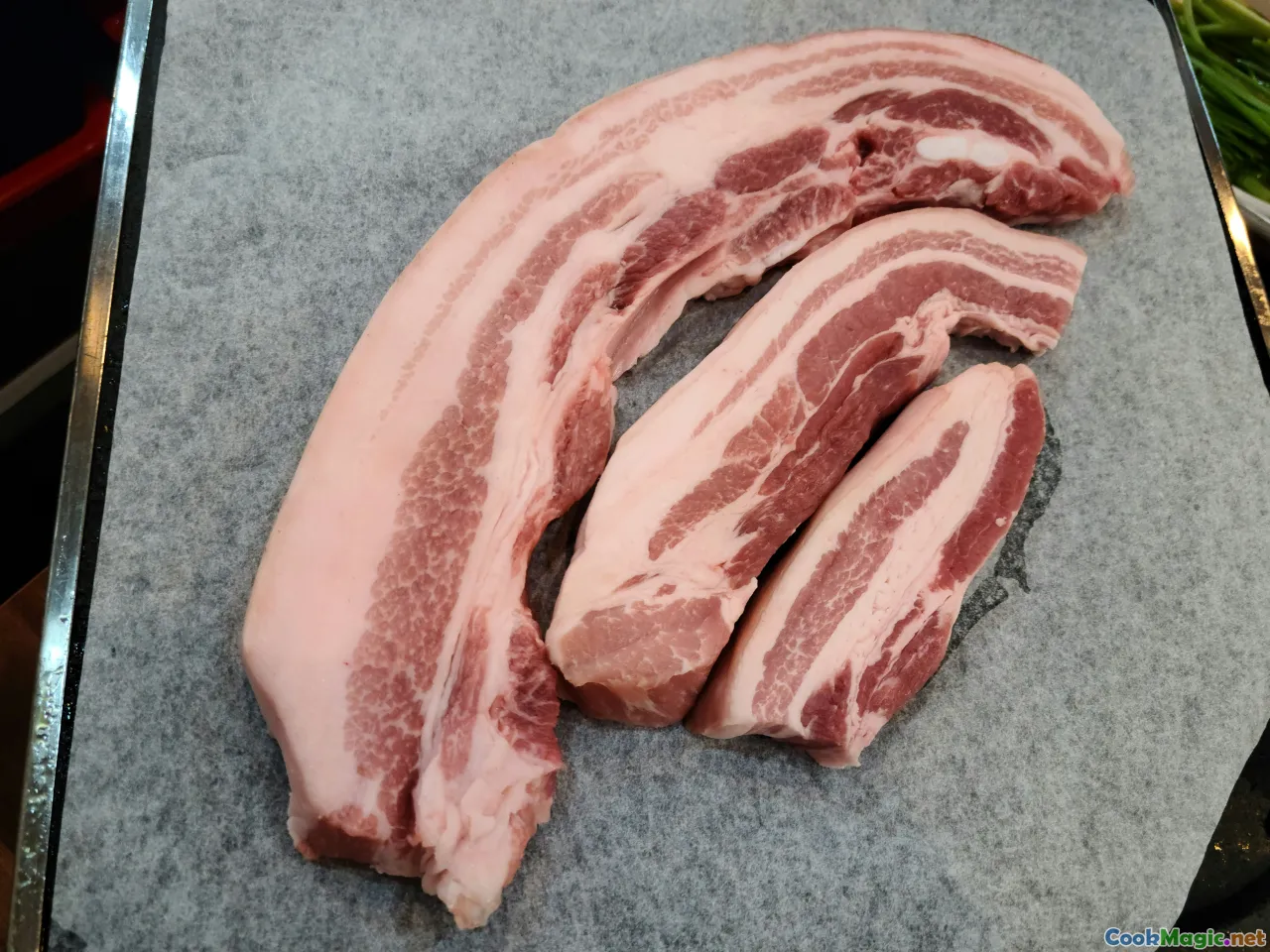
Südliche Pfannen-Grünkohl mit knusprigem Speck
(Southern Skillet Collard Greens with Crispy Bacon)
(0 Bewertungen)0
1,121
Juli 16, 2025
Problem melden
Zutaten
-
500 grams Grünkohl
(Frische Blätter, dicke Stiele entfernt und gehackt)
-
150 grams Bacon
(geräuchert, in kleine Stücke geschnitten)
-
1 medium Gelbe Zwiebel
(Fein gewürfelt)
-
3 cloves Knoblauch
(Gehackt)
-
2 tbsp Apfelessig
(Verleiht dem Grünzeug Glanz.)
-
400 ml Hühnerbrühe
(Kann durch Gemüsebrühe für eine vegetarische Option ersetzt werden.)
-
1 tbsp Olivenöl
(Verstärkt den Geschmack, besonders um Speck knusprig zu machen.)
-
0.5 tsp Rote Pfefferflocken
(Optional, für eine milde Schärfe.)
-
0.5 tsp Salz
(Abschmecken; nach Bedarf anpassen.)
-
0.5 tsp Schwarzer Pfeffer
(Frisch zerstoßen oder gemahlen)
(Frische Blätter, dicke Stiele entfernt und gehackt)
(geräuchert, in kleine Stücke geschnitten)
(Fein gewürfelt)
(Gehackt)
(Verleiht dem Grünzeug Glanz.)
(Kann durch Gemüsebrühe für eine vegetarische Option ersetzt werden.)
(Verstärkt den Geschmack, besonders um Speck knusprig zu machen.)
(Optional, für eine milde Schärfe.)
(Abschmecken; nach Bedarf anpassen.)
(Frisch zerstoßen oder gemahlen)
Nährwerte
- Portionen: 4
- Portionsgröße: 1 Schüssel (200g)
- Calories: 195 kcal
- Carbohydrates: 10 g
- Protein: 11 g
- Fat: 12 g
- Fiber: 4 g
- Sugar: 2 g
- Sodium: 550 mg
- Cholesterol: 25 mg
- Calcium: 130 mg
- Iron: 1.8 mg
Anweisungen
-
1 - Bereite die Collard Greens vor.:
Entferne die dicken Stiele der Collard-Blätter. Gründlich abspülen, dann stapeln, aufrollen und die Blätter in feine Streifen schneiden.
-
2 - Brate den Bacon knusprig:
Geben Sie Olivenöl in eine große Pfanne und erhitzen Sie sie bei mittlerer Hitze. Braten Sie die Speckstücke, bis sie knusprig sind, ca. 5–7 Minuten. Nehmen Sie sie mit einem Schaumlöffel heraus und stellen Sie sie beiseite, wobei das ausgelassene Fett in der Pfanne bleibt.
-
3 - Zwiebel und Knoblauch anbraten:
Geben Sie die gewürfelten Zwiebeln in die Pfanne mit dem Speckfett. Braten Sie sie, bis sie weich sind, ca. 3 Minuten, dann geben Sie den Knoblauch hinzu und braten ihn eine Minute lang, bis er duftet.
-
4 - Koche Blätterkohl:
Collard-Blätter in die Pfanne geben. Umrühren, damit sie gleichmäßig bedeckt sind, und 2–3 Minuten kochen. Hühnerbrühe hinzufügen, zum Köcheln bringen, abdecken und 10–12 Minuten kochen, gelegentlich umrühren, bis das Grünzeug zart ist.
-
5 - Würze und gib Speck hinzu.:
Deckel entfernen. Fügen Sie Apfelessig, rote Pfefferflocken (falls verwendet), Salz und schwarzen Pfeffer hinzu. Geben Sie den Speck zurück in die Pfanne und rühren Sie gut um. Unbedeckt köcheln, bis der Großteil der Flüssigkeit verdampft.
-
6 - Servieren:
Würzen Sie nach Geschmack, dann überführen Sie Grünkohlblätter mit Speck in Servierschalen. Servieren Sie heiß als Beilage oder als herzhaftes Mittagessen.
Entferne die dicken Stiele der Collard-Blätter. Gründlich abspülen, dann stapeln, aufrollen und die Blätter in feine Streifen schneiden.
Geben Sie Olivenöl in eine große Pfanne und erhitzen Sie sie bei mittlerer Hitze. Braten Sie die Speckstücke, bis sie knusprig sind, ca. 5–7 Minuten. Nehmen Sie sie mit einem Schaumlöffel heraus und stellen Sie sie beiseite, wobei das ausgelassene Fett in der Pfanne bleibt.
Geben Sie die gewürfelten Zwiebeln in die Pfanne mit dem Speckfett. Braten Sie sie, bis sie weich sind, ca. 3 Minuten, dann geben Sie den Knoblauch hinzu und braten ihn eine Minute lang, bis er duftet.
Collard-Blätter in die Pfanne geben. Umrühren, damit sie gleichmäßig bedeckt sind, und 2–3 Minuten kochen. Hühnerbrühe hinzufügen, zum Köcheln bringen, abdecken und 10–12 Minuten kochen, gelegentlich umrühren, bis das Grünzeug zart ist.
Deckel entfernen. Fügen Sie Apfelessig, rote Pfefferflocken (falls verwendet), Salz und schwarzen Pfeffer hinzu. Geben Sie den Speck zurück in die Pfanne und rühren Sie gut um. Unbedeckt köcheln, bis der Großteil der Flüssigkeit verdampft.
Würzen Sie nach Geschmack, dann überführen Sie Grünkohlblätter mit Speck in Servierschalen. Servieren Sie heiß als Beilage oder als herzhaftes Mittagessen.
Mehr über: Südliche Pfannen-Grünkohl mit knusprigem Speck
Collard Greens with Bacon — Southern Tradition in Every Bite
Collard greens have a deeply rooted history in Southern American cuisine, stretching back over generations and oceans. Originating in Africa and Europe, leafy greens like collards became staple crops across the southern United States due to their resilient nature and hearty, nutritious leaves. Collard greens with bacon is an iconic dish—earthy greens slow-simmered until melt-in-your-mouth tender, enriched with smoky bacon, sweet onions, and spiked with a splash of vinegar to balance the richness.
History & Cultural Significance
For enslaved African Americans residing in the Antebellum South, collards were cultivated in gardens as essential sources of nutrition. Traditionally, they were slow-cooked with smoked meats (ham hocks, fatback, or bacon) to bring extra body and warmth, flavors that became emblematic of African American and Southern cuisine. Every Black family, and indeed, many white households in places like Georgia, the Carolinas, and Alabama developed their own approaches to seasoning, braising, and serving collard greens, often with personal or regional flourishes.
The custom of adding vinegar reflects West African cooking traditions, where acid is often used to brighten the intensity of long-cooked stews. Even today, a jar of peppered vinegar frequently sits on the table alongside greens.
Personal Tips & Notes
- Prepping the Greens: Always remove the thick center ribs—these don't tenderize well and can add unwanted bitterness. For speed, try stacking several leaves, rolling tightly, and slicing into 'chiffonade' style ribbons.
- Choosing Bacon: Use high-quality, smoky bacon for depth. Alternatively, try adding chopped smoked sausage or a ham hock for even more flavor, or opt for a plant-based bacon or smoked tofu for a vegetarian version.
- Simmering Liquid: Chicken stock gives a rounded base, but if making vegetarian, try mushroom or vegetable stock with a splash of smoked paprika.
- Final Touch: The table vinegar is traditional—pass a small bottle for diners wishing to add extra tang. Vinegar can cut through the greens' natural brassica bitterness and bacon's richness at the last second.
- Leftovers & Storage: These collard greens taste even better the next day. Refrigerate in an airtight container and enjoy within three days. Reheat gently over the stove with a splash of water or stock to restore moisture.
Creative Variations
For an intriguing, creative spin, add chopped sun-dried tomatoes or a pinch of brown sugar at the end for sweetness, or toss in a can of drained white beans to make a complete one-skillet meal. Chopped jalapeños roasted with bacon briefly or a sprinkle of toasted pecans over the top brings new depths and crunch. Steep collards in miso-infused broth for a unique global twist.
Beyond the Side — Serving Ideas
While classic Southern plates offer collards alongside cornbread, barbecue meats, or fried chicken, don’t hesitate to serve these as a main element for lunch over cheesy grits, as part of a rice bowl, or folded into a breakfast sandwich with egg. Their savory and comforting taste profile brings a warm balance at any time of day.
Quick Nutrition Glimpse
Collards bring potent doses of vitamins A, C, and K, calcium, and dietary fiber, supporting strong bones and digestion. Coupled with protein and healthy fats from bacon, this dish is a filling source of comfort-food nutrition.
The joyous blend of old-world culinary knowledge refined on this continent makes collard greens with bacon more than a recipe—it’s a celebration of history, resourcefulness, and flavor. Whether you grew up alongside a pot of simmering greens or you’re trying this Southern mainstay for the very first time, you’re partaking in a beloved legacy that links countless kitchens across centuries.

























